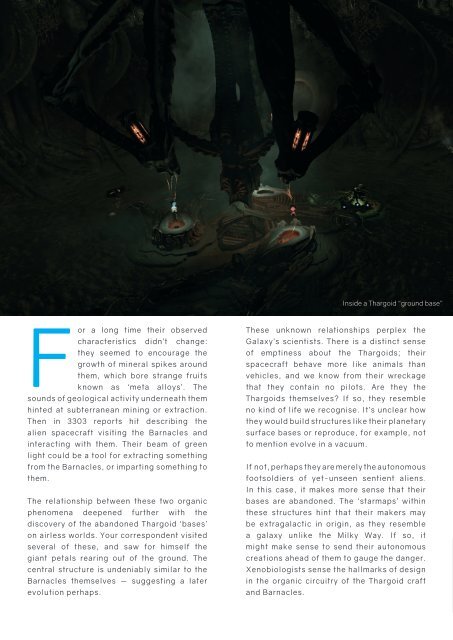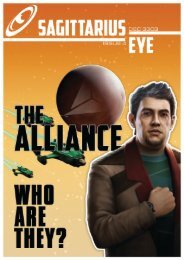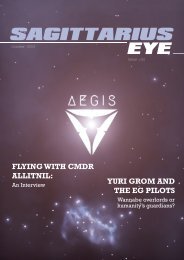Sag Eye Issue 5
You also want an ePaper? Increase the reach of your titles
YUMPU automatically turns print PDFs into web optimized ePapers that Google loves.
Historians recall a thinker from our species’<br />
forced to revisit the core assumption that we<br />
uniplanetary days. Enrico Fermi in the<br />
were alone in our sophistication. Not only<br />
Twentieth Century asked where, given the<br />
had the Guardians been a complex, social,<br />
abundance of worlds conducive to life in<br />
spacefaring species, but they had been right<br />
the Milky Way, were all the other sentient<br />
on our doorstep - a mere thousand light years<br />
species? It took our species a mere 60,000<br />
away, barely one percent of the expanse of<br />
years to evolve from the sort of non-cognisant<br />
the Galaxy. And they were gone.<br />
species we routinely encounter to our current<br />
interstellar selves — a blink of an eye in cosmic<br />
This was terrible news for our species. If a<br />
terms. Where are all the other civilisations?<br />
sentient species can gain the ability to travel<br />
beyond one planet so close to us, probability<br />
A possible explanation was posited in the<br />
dictates that there should be somewhere in the<br />
‘Great Filter’. This is a cataclysmic event<br />
order of magnitude of 3,400 other spacefaring<br />
sufficient to extinguish all complex life — like<br />
species in the Milky Way, assuming an equal<br />
an asteroid impact or an interstellar burst<br />
distribution.<br />
of radiation — which strikes every planet<br />
frequently and regularly enough to prohibit<br />
But there’s aren’t. Since consumer-level<br />
any one organism evolving to a level of<br />
frame shift drives hit the market humans have<br />
intelligence that permit them to leave that<br />
explored nearly every corner of our galaxy. The<br />
planet. This ‘Great Filter’ ensures that sentient<br />
EDSM is an organisation of cartographers who,<br />
life in the Milky Way is incredibly rare.<br />
in association with Universal Cartographics,<br />
plot the courses of most independent pilots.<br />
Scientists in Fermi’s time accepted this.<br />
The image below shows our galaxy, with a thin<br />
Earth’s geological record indicated that there<br />
white line for ships’ routes over the last three<br />
Inside a Thargoid “ground base”<br />
had been five extinction-level incidents in<br />
years.<br />
that planet’s short history, and their grouping<br />
For a long time their observed<br />
characteristics didn’t change:<br />
they seemed to encourage the<br />
growth of mineral spikes around<br />
them, which bore strange fruits<br />
known as ‘meta alloys’. The<br />
sounds of geological activity underneath them<br />
hinted at subterranean mining or extraction.<br />
Then in 3303 reports hit describing the<br />
alien spacecraft visiting the Barnacles and<br />
interacting with them. Their beam of green<br />
light could be a tool for extracting something<br />
from the Barnacles, or imparting something to<br />
them.<br />
The relationship between these two organic<br />
phenomena deepened further with the<br />
discovery of the abandoned Thargoid ‘bases’<br />
These unknown relationships perplex the<br />
Galaxy’s scientists. There is a distinct sense<br />
of emptiness about the Thargoids; their<br />
spacecraft behave more like animals than<br />
vehicles, and we know from their wreckage<br />
that they contain no pilots. Are they the<br />
Thargoids themselves? If so, they resemble<br />
no kind of life we recognise. It’s unclear how<br />
they would build structures like their planetary<br />
surface bases or reproduce, for example, not<br />
to mention evolve in a vacuum.<br />
If not, perhaps they are merely the autonomous<br />
footsoldiers of yet-unseen sentient aliens.<br />
In this case, it makes more sense that their<br />
bases are abandoned. The ‘starmaps’ within<br />
these structures hint that their makers may<br />
be extragalactic in origin, as they resemble<br />
indicated that we were well overdue another.<br />
Soon after, we began colonising Mars and<br />
beyond, and our proverbial eggs were no<br />
longer all in one planetary basket.<br />
This eloquently explained the conundrum<br />
of our loneliness: there were no other<br />
spacefaring species because the galaxy<br />
tended to nuke planets before those societies<br />
could evolve. We had escaped by fluke, and<br />
then placed ourselves beyond risk by our<br />
cleverness. The ‘Great Filter’ was behind us;<br />
this theory made sense and flattered us at the<br />
same time. The small matter of the mysterious<br />
alien relic allegedly discovered on Mars was<br />
brushed out of sight.<br />
Then the Guardians ruins were<br />
discovered. Suddenly xenologists were<br />
on airless worlds. Your correspondent visited<br />
a galaxy unlike the Milky Way. If so, it<br />
several of these, and saw for himself the<br />
might make sense to send their autonomous<br />
giant petals rearing out of the ground. The<br />
central structure is undeniably similar to the<br />
Barnacles themselves — suggesting a later<br />
evolution perhaps.<br />
creations ahead of them to gauge the danger.<br />
Xenobiologists sense the hallmarks of design<br />
in the organic circuitry of the Thargoid craft<br />
and Barnacles.<br />
A U T H O R<br />
PH Souvarine is an experienced field reporter. He writes about current affairs, galactic politics<br />
and discovery. His Sidewinder-class press ship, the Salty Weasel, can often be spotted in the<br />
heat of the action, ferreting out the story.






